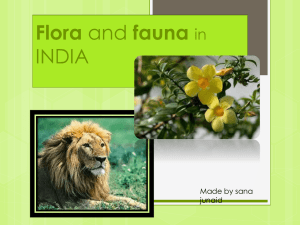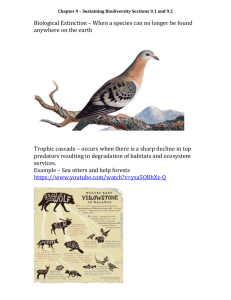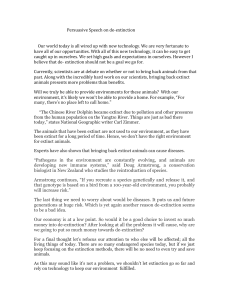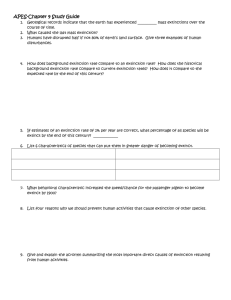Interview with an Extinction Specialist
advertisement
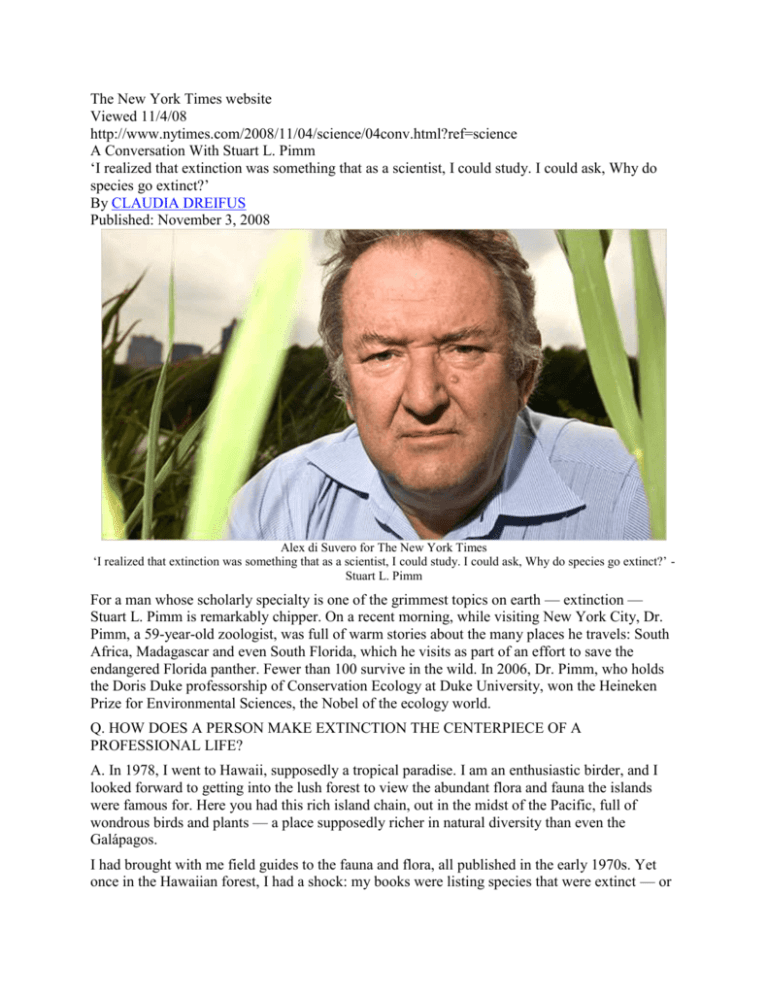
The New York Times website Viewed 11/4/08 http://www.nytimes.com/2008/11/04/science/04conv.html?ref=science A Conversation With Stuart L. Pimm ‘I realized that extinction was something that as a scientist, I could study. I could ask, Why do species go extinct?’ By CLAUDIA DREIFUS Published: November 3, 2008 Alex di Suvero for The New York Times ‘I realized that extinction was something that as a scientist, I could study. I could ask, Why do species go extinct?’ Stuart L. Pimm For a man whose scholarly specialty is one of the grimmest topics on earth — extinction — Stuart L. Pimm is remarkably chipper. On a recent morning, while visiting New York City, Dr. Pimm, a 59-year-old zoologist, was full of warm stories about the many places he travels: South Africa, Madagascar and even South Florida, which he visits as part of an effort to save the endangered Florida panther. Fewer than 100 survive in the wild. In 2006, Dr. Pimm, who holds the Doris Duke professorship of Conservation Ecology at Duke University, won the Heineken Prize for Environmental Sciences, the Nobel of the ecology world. Q. HOW DOES A PERSON MAKE EXTINCTION THE CENTERPIECE OF A PROFESSIONAL LIFE? A. In 1978, I went to Hawaii, supposedly a tropical paradise. I am an enthusiastic birder, and I looked forward to getting into the lush forest to view the abundant flora and fauna the islands were famous for. Here you had this rich island chain, out in the midst of the Pacific, full of wondrous birds and plants — a place supposedly richer in natural diversity than even the Galápagos. I had brought with me field guides to the fauna and flora, all published in the early 1970s. Yet once in the Hawaiian forest, I had a shock: my books were listing species that were extinct — or about to become so. I was in the forest six days a week and I kept thinking, “If I give it enough time, I’ll certainly see most of the species still left.” But I saw very little. In fact, in Hawaii today, I’d say there are only about 10 remaining native land bird species, with another 10 clinging to survival. So suddenly this extinction business seemed very real. Whenever you’d meet biologists over coffee, there’d be the same conversation: “Do you ever wonder what Hawaii was like before, with 150 species of birds and 1,500 species of plants?” That changed my life. Q. HOW DID IT DO THAT? A. Well, I realized that extinction was something that as a scientist, I could study. I could ask, “Why do species go extinct?” and “How fast does it happen?” Once armed with that information, one might do something about it. I now spend a fair amount of time in Washington, working for laws to protect species. I train young people to do the same. I often tell my students that if they want to become environmental biologists, they have to be prepared to go out into the field at dawn to collect their data and then dress up in a suit in the afternoon to meet the visiting politician. Q. WHICH WOULD YOU SAY ARE, AT THIS MOMENT, THE MOST ENDANGERED OF THE WORLD’S CREATURES? A. There are too many to name. Something like 12 percent of all birds, a third of all amphibians and, likely, similarly large numbers of plants are in serious danger, I’d say. What’s more, about 1 percent of all species on the planet are in such trouble that if we don’t do the right things immediately they will be gone in a decade. The river dolphin in China was declared extinct just last year. Another small dolphin in the Sea of Cortez is in immediate danger. Q. WHAT CAN ONE PERSON DO TO STOP EXTINCTIONS? A. One of the things I’ve done is start an NGO — a nongovernmental organization — called SavingSpecies.org. And it does what its title suggests. We’ve been working with local conservation groups and governments in Brazil and Madagascar doing a variety of projects that we hope will halt the potential extinctions there. One of the things we know is that many endangered animals live over large areas. But their populations become fragmented because of farming and development. The remaining creatures can’t find a date on a Saturday night. So we’ve been trying to buy up degraded land around their broken environments and try to create land corridors for the wildlife. Q. HAVE YOU HAD ANY SUCCESSES YET? A. Yes. On the Atlantic Coast of Brazil, we’ve been trying to help save the golden lion tamarin, an endangered primate about the size of a house cat. Last year, with the involvement of local conservationist groups, we helped purchase about 270 acres of cattle pasture that separated two patches of their habitat. This former pasture is now being replanted with trees. The two areas will soon be bridged, and it will be possible for lonely hearts to meet members of the opposite sex and go forth and multiply. In another South American region I won’t name here, there have been a lot of illegal logs taken. Why? Because a local godfather there was getting kickbacks from loggers. My friends and I decided we’d give him a bit more money and we stopped the illegal logging. I may burn in hell forever for paying protection, but it did help the animals and the indigenous people, who were not subjected to a lot of bad things. In terms of what we got for the money, it was a very good deal. Q. YOUR GROUP HAS BEEN DOING A LOT OF WORK WITH INDIGENOUS TRIBES. WHY IS THAT IMPORTANT? A: Because when you set aside indigenous reserves, it reduces deforestation. There’s another project in Northern Amazonia that my group has been involved in. This particular area is inhabited by indigenous peoples who have clear title to the land in their village. Recently, settlers came into the area, wanting to turn the forests outside of the village — the very places where these people hunt and fish — into rice fields. Their claim was that no one owned the forests. So my Brazilian students and a local Catholic mission have been teaching the tribe’s teenagers the use of modern global positioning technologies — G.P.S. The idea is that G.P.S. can help them can record where they hunt and fish and that will help them define the forest land as theirs. So here’s an example of when we help the local people maintain their traditional ways, we’re helping the flora and the fauna survive. Q. HOW DO YOU FINANCE SAVINGSPECIES.ORG? A. We raise money in the traditional way, but we’re also selling symbolic carbon offsets to sympathetic donors. As you know, when you restore forests, you soak up CO2 from the atmosphere. There are people who’d like to be carbon neutral — they’d like not to burn any more carbon than they are soaking up. So if someone buys an airline ticket and feels badly about all the carbon they’re putting into the atmosphere during that flight, we sell them very beautiful, very cheap offsets from the forest restoration we have done. We hope that this kind of swap will eventually become a financial obligation in a lot of the world. Q. ARE YOU RELIGIOUS? A. I’m a believing Christian. “God so loved the cosmos that he gave his only son.” That’s an injunction from St. John. To me, this says that Christians have an obligation to look after the world — stewardship. We cannot pointlessly drive species to extinction and destroy forests and oceans. When we do that, we are destroying God’s creation. That said, I’m not a vegetarian. I like a good steak now and then. Do I go out and slaughter cattle? Yep.



